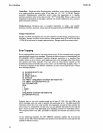
Disk File
Input/Output
5-2
String and numeric expressions can replace any
of
the parameters:
OPEN M$,FN,
DN$+
"OUTPUT"
This statement opens a file for either input or output, depending
on
the value of M$
(it must be either
"I"
or
"0")
and
assigns the file number represented by FN (it
must be from 1 to 6). The name
of
the file
is
the value
of
the string variable DN$ (it
should be
":FO:"
through
":F9:",
depending
on
how many drives you have, or null)
followed by the
six
characters
OUTPUT.
NOTE
Remember that opening a file for output destroys
an
existing file
of
the
same name.
Writing to a Sequential File
After you open a sequential file for output, you can write data to it with the
PRINT
statement.
If
you open an existing file for output, its contents are deleted.
To
specify
that a
PRINT
statement
is
being used to write to a sequential disk file, the file
number (preceded by
#, followed by a comma) follows the word PRINT.
To
print a series
of
constants and variables to file 3:
PRINT
#3,
"Today's
date is
";MO$;OA;",";YR
You can also use the full formatting capabilities of the
PRINT
USING statement:
PRINT
#3
USING, "###,##;"234.41 ;81.20;4.68
Refer to Chapter 6 for further details of
PRINT
USING.
Reading from a Sequential File
After you open a sequential file for input, you can read data from it with the INPUT
and LINE INPUT statements.
To
specify that these statements are being used to
read from a sequential disk file, the file number (preceded by
# and followed by a
comma) follows the word
INPUT
or
LINE INPUT.
The INPUT statement reads the specified number
of
values (numeric or string) from
the disk file. Numeric values (in the disk file) can be separated by a blank, comma,
carriage return, or line feed.
String values can be enclosed in quotation marks, or given as unquoted strings.
Quoted strings terminate
on
the quote marks, while unquoted strings terminate
on
commas, carriage returns, line feeds, or if they exceed
255
characters in length.
Assume, for example, that disk file
#2
contains the following
data
(a new line
represents a carriage return-line feed pair in the disk file):
"R1"
,200,
"R2"
,2200,
"R3"
,10000
"R4"
,.47
After the file
is
opened for input, the following INPUT statement would assign a
string value to
R$
and the subsequent numeric value to R:
INPUT #2,R$,R
If
executed four times, it would read all eight values.
BASIC-SO


















